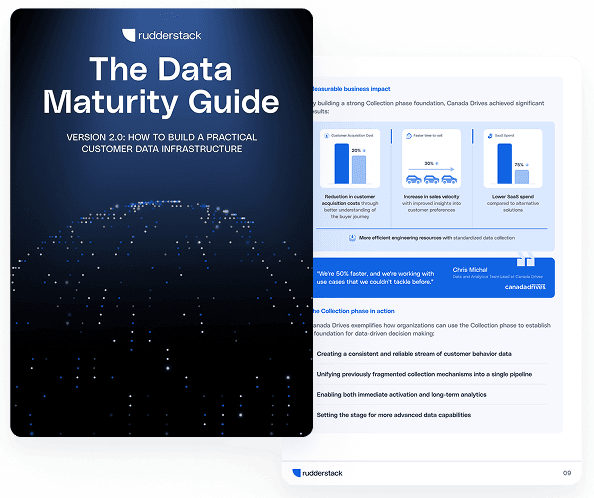AI infrastructure 101: Building the foundation for ML

Building AI models is only half the battle. Without the right AI infrastructure, even the smartest algorithms stall before reaching production. You need more than just powerful hardware or clever code. True AI success starts with a solid foundation. One that keeps your data moving, your models learning, and your team in control.
In this guide, we'll break down what AI infrastructure means, including the core layers you need to support scalable model development, training, and deployment.
From data pipelines and compute to orchestration and governance, we'll walk through how modern teams can build production-ready AI systems from the ground up. You'll also learn where RudderStack fits in as a warehouse-native data infrastructure layer that ensures real-time, governed, and high-quality data flows into your AI pipelines at every stage.
Main takeaways:
- AI infrastructure is a purpose-built stack of compute, storage, and orchestration tools designed to support the full machine learning lifecycle
- Specialized hardware like GPUs and TPUs, combined with frameworks such as TensorFlow and Kubernetes, are essential for scalable and efficient AI workloads
- Robust data pipelines and real-time processing capabilities are critical for training, deploying, and maintaining production-grade models
- Security, governance, and compliance must be embedded into infrastructure from day one to ensure responsible and auditable AI
- RudderStack helps teams unify, govern, and activate customer data across their AI infrastructure to accelerate model development and deployment
What is AI infrastructure?
AI infrastructure is the technical foundation that enables organizations to develop, train, and deploy artificial intelligence and machine learning models effectively. It consists of specialized hardware, software frameworks, data storage systems, and networking components designed for high-performance AI workloads.
Traditional IT systems aren't built to handle the massive computational demands of modern AI. So, what is an AI infrastructure that can support these needs? It's a purpose-built system that processes large datasets, manages complex algorithms, and delivers reliable model performance at scale.
The AI infrastructure meaning extends beyond just hardware. It encompasses the entire ecosystem needed to support AI development, from data pipelines to deployment tools.
Why AI infrastructure matters for modern ML
Without a strong artificial intelligence infrastructure, AI initiatives can face significant bottlenecks. Proper infrastructure can reduce training time from weeks to hours and enable you to deploy models confidently.
Your choice of an AI infrastructure stack directly impacts how quickly you can iterate on models and how effectively they perform in production. This infrastructure provides the computational power, data access, and operational tools needed for successful AI implementation.
Modern machine learning, especially deep learning and generative AI, requires specialized resources that general-purpose IT systems cannot provide efficiently. Supporting large language models (LLMs) introduces additional demands in memory capacity, training speed, and deployment latency, making infrastructure a key competitive differentiator.
Key components of an effective AI environment
To build production-grade AI systems, you need more than just compute power. The components below work together to support data movement, model training, and orchestration at scale, forming the backbone of any effective AI environment.
AI hardware: GPUs, TPUs, and accelerators
The foundation of AI in infrastructure starts with specialized processing hardware. Graphics Processing Units (GPUs) excel at parallel processing tasks common in AI workloads. Tensor Processing Units (TPUs) are custom-designed chips optimized specifically for machine learning.
Your choice of hardware depends on your specific AI workloads. Training large models requires different resources than running inference in production.
AI compute infrastructure options include:
- GPUs: Best for deep learning and general AI workloads, offering thousands of cores for parallel processing. NVIDIA's A100 and H100 provide massive throughput for training large language models, while consumer-grade options like RTX series cards work well for smaller projects.
- TPUs: Optimized for TensorFlow and large-scale training with specialized matrix multiplication units. Google Cloud TPU v4 pods can deliver 9 exaflops of computing power, making them ideal for transformer-based architectures and massive dataset processing.
- FPGAs: Customizable for specific AI applications through reprogrammable hardware circuits. These offer lower latency than GPUs for inference tasks and can be fine-tuned for edge computing scenarios where power efficiency matters, like in autonomous vehicles or industrial IoT.
- ASICs: Application-specific chips for maximum efficiency, designed exclusively for particular AI workloads. Examples include Google's Edge TPU, Apple's Neural Engine, and custom silicon from companies like Cerebras and Graphcore that deliver 10-100x better performance-per-watt for targeted applications.
AI software frameworks and orchestration tools
Software is equally important in your AI infrastructure architecture. You need frameworks for building models, tools for managing workflows, and systems for monitoring performance.
Popular frameworks include TensorFlow, PyTorch, and scikit-learn. TensorFlow is often preferred for production-grade models and integration with tools like TFX and Vertex AI, while PyTorch is widely used in research and experimentation for its dynamic computation graph. Scikit-learn remains a go-to for traditional machine learning.
For orchestration, tools like Airflow, Kubeflow Pipelines, and MLflow play key roles. Airflow excels at DAG-based workflow scheduling, while Kubeflow Pipelines is designed for Kubernetes-native ML orchestration. MLflow adds lightweight tracking and model versioning capabilities, making it popular for experiment management.
Together, these frameworks and orchestrators form the backbone of repeatable, scalable machine learning pipelines, and their choice should align with your team's skill set and target deployment environment.
Data storage and networking for AI performance
Effective AI infrastructure requires robust storage and real-time data systems:
- Storage: Distributed file systems, object storage, ML data lakes
- Networking: High-bandwidth, low-latency links between compute and data
- Streaming: Real-time pipelines enable online learning and adaptive models
Real-time data pipelines are essential for applications that need continuous learning or immediate insights. These systems process data as it's generated, enabling dynamic model updates and fast decision-making.
How RudderStack fits into AI infrastructure:
| Capability | How RudderStack supports it |
|---|---|
| Real-time data ingestion | Event Stream pipelines capture and route behavioral data with low latency |
| Schema enforcement at collection | Validates incoming events against tracking plans before they reach storage or modeling layers |
| Identity resolution | Warehouse-native identity graphs unify user data across devices, channels, and sessions |
| Feature store & model integration | Feeds unified profiles and computed traits directly into ML tools and feature stores |
| Governance and control | Privacy-first infrastructure with consent enforcement and audit logging built in |
How to plan and implement AI infrastructure
Planning and implementing AI infrastructure requires a strategic, phased approach. From assessing current capabilities to enforcing governance and scaling responsibly, each step lays the foundation for long-term success.
1. Assess current data workflows
Begin by mapping your current data and ML ecosystem:
- Inventory your resources: What compute, storage, and networking capabilities already exist? Are they cloud-based, on-premises, or hybrid?
- Evaluate data maturity: Where does your data live? Is it unified, siloed, or inconsistent? Can you support real-time pipelines or only batch jobs?
- Assess skill sets: Does your team have experience with data engineering, model training, orchestration tools, and infrastructure-as-code?
- Clarify use cases: Outline which business problems you're solving with AI, such as fraud detection, personalization, churn prediction, or LLM-driven chat.
Identifying these elements helps you tailor your infrastructure decisions to actual needs, not assumptions.
2. Identify hardware, software, and network needs
Once your needs are clear, map them to infrastructure components:
- Hardware: Will your models require GPUs (deep learning), TPUs (LLMs), or CPUs (classic ML)? Will inference run in the cloud or at the edge?
- Software: Choose ML frameworks (TensorFlow, PyTorch), orchestration tools (Airflow, Kubeflow), and versioning systems (MLflow, Weights & Biases) that your team can support.
- Data stack: Decide whether you'll centralize data in a lakehouse, lake, or warehouse—and what ingestion and transformation tools you'll need (e.g., RudderStack, dbt, Delta Lake).
- Deployment model: Cloud, on-prem, or hybrid? A cloud-native strategy may offer speed, while on-prem may be required for security or latency.
Ensure that chosen tools are modular and interoperable. Avoid vendor lock-in by prioritizing open standards and future-proof APIs.
See Rudderstack in action
Ready to streamline your AI data stack? Request a demo to see how RudderStack can help you unify, govern, and activate your data for AI and ML initiatives.
3. Execute a phased rollout
Avoid a full-scale rollout all at once. Instead, follow a phased deployment strategy:
- Start small: Choose a high-impact but low-risk use case to pilot (e.g., model-driven lead scoring or intelligent support routing).
- Test & measure: Monitor latency, training time, model accuracy, and deployment reliability during the pilot.
- Iterate: Use learnings from the pilot to fine-tune resource sizing, tooling, and security policies.
- Scale intentionally: Gradually onboard additional use cases, data teams, and models into the infrastructure.
This approach reduces technical debt and allows for operational tuning without business disruption.
4. Maintain, monitor, and evolve
AI infrastructure requires continuous refinement. Once deployed, you should:
- Monitor performance: Use observability tools to track model throughput, drift, compute utilization, and storage growth.
- Track cost: Implement FinOps practices like cost tagging, usage alerts, and budget enforcement for cloud workloads.
- Evolve workflows: As business needs shift, update orchestration DAGs, refactor pipelines, and re-tune models.
- Close the loop: Add telemetry from real-world outcomes back into data pipelines to support online learning and model improvement.
Infrastructure health is tied directly to business outcomes. Without ongoing monitoring and feedback, AI systems stagnate or fail silently.
Ensuring governance, privacy, and security in AI infrastructure
Modern AI systems carry significant risk if not governed properly. A secure, auditable infrastructure helps prevent data misuse, protects customer trust, and ensures regulatory compliance.
Data protection and privacy
Protect data at every stage of the AI lifecycle:
- Encryption: Apply at-rest and in-transit encryption using standards like AES-256 and TLS 1.2+.
- Access controls: Use role-based permissions and single sign-on to prevent unauthorized access to sensitive features or data.
- Privacy-preserving techniques: Adopt differential privacy, homomorphic encryption, or federated learning for sensitive datasets (e.g., healthcare or financial data).
These measures are essential for GDPR, HIPAA, and CCPA compliance and for safeguarding PII in production ML systems.
Compliance and monitoring
AI infrastructure must be auditable and compliant:
- Audit logs: Capture changes to infrastructure, model parameters, and data access patterns.
- Model lineage: Track model versions, data inputs, and transformations for each deployed system.
- Standards alignment: Ensure infrastructure adheres to SOC 2, ISO 27001, or FedRAMP requirements, especially for regulated industries.
Use dashboards and alerts to flag policy violations or suspicious behavior in real time.
Responsible AI development
Governance also applies to model behavior:
- Bias and fairness checks: Regularly validate models against fairness metrics (e.g., demographic parity, equalized odds).
- Transparency: Document model purpose, inputs, training data sources, and known limitations.
- Accountability: Assign clear ownership of each model and its performance in production.
Responsible AI requires more than good intentions—it demands enforceable processes supported by infrastructure.
Deployment models and scalability strategies
Selecting the right deployment model is key to balancing performance, cost, and control.
On-premises vs. cloud vs. hybrid
Your infrastructure can be deployed in three main configurations:
- On-premises: Best for strict data locality, compliance, or latency requirements (e.g., financial services, defense).
- Cloud-based: Ideal for flexibility, experimentation, and elastic scaling—popular with SaaS, retail, and startups.
- Hybrid: Combines both approaches; common in enterprises that need cloud agility but retain certain systems on-prem.
Use hybrid if you need to isolate sensitive workloads while still benefiting from cloud scalability for training.
Scaling strategies for growing AI workloads
As your AI footprint grows, ensure your infrastructure scales with it:
- Horizontal scaling: Add more machines (or containers) to distribute workload—ideal for stateless training jobs or inference clusters.
- Vertical scaling: Upgrade hardware with more memory, faster storage, or more powerful accelerators (e.g., GPU-to-TPU migration).
- Orchestration tools: Use Kubernetes, Ray, or Flyte to manage autoscaling and fault tolerance across distributed resources.
Build in elasticity early to avoid re-architecture later. Automate scaling policies based on compute usage, queue length, or request volume.
Building a future-ready AI foundation with RudderStack
A well-designed AI infrastructure stack enables innovation while maintaining control. It provides the foundation for developing, deploying, and managing AI applications efficiently.
RudderStack's cloud-native customer data infrastructure helps you build a solid foundation for AI initiatives. It unifies your data sources, ensures governance, and enables real-time activation.
With RudderStack, you can:
- Collect and unify customer data from all sources
- Ensure data quality and governance
- Activate data in real-time for AI and analytics
- Maintain complete control over your data
To learn how RudderStack can help strengthen your AI infrastructure architecture, request a demo. You can also meet us at Big Data LDN in September to discuss your AI infrastructure needs.
FAQs about AI infrastructure
What is the difference between AI infrastructure and traditional IT infrastructure?
AI infrastructure is specifically designed for the high computational demands of machine learning workloads, featuring specialized processors like GPUs and TPUs, parallel computing capabilities, and optimized data pipelines that traditional IT systems don't typically include.
What does an AI infrastructure engineer do?
An AI infrastructure engineer designs, builds, and maintains the systems that support machine learning workflows. This includes managing compute resources, data pipelines, model training environments, and deployment tools. Their goal is to ensure AI systems are scalable, reliable, and efficient in production.
Published:
August 12, 2025

Event streaming: What it is, how it works, and why you should use it
Event streaming allows businesses to efficiently collect and process large amounts of data in real time. It is a technique that captures and processes data as it is generated, enabling businesses to analyze data in real time

RudderStack: The essential customer data infrastructure
Learn how RudderStack's customer data infrastructure helps teams collect, govern, transform, and deliver real-time customer data across their stack—without the complexity of legacy CDPs.

Scaling data products starts with fixing the foundation: Five lessons we’ve learned
Most teams don’t have a modeling problem—they have a foundation problem. This post shows how to standardize your pipeline, put one owner in charge, and use observability to scale data products.






